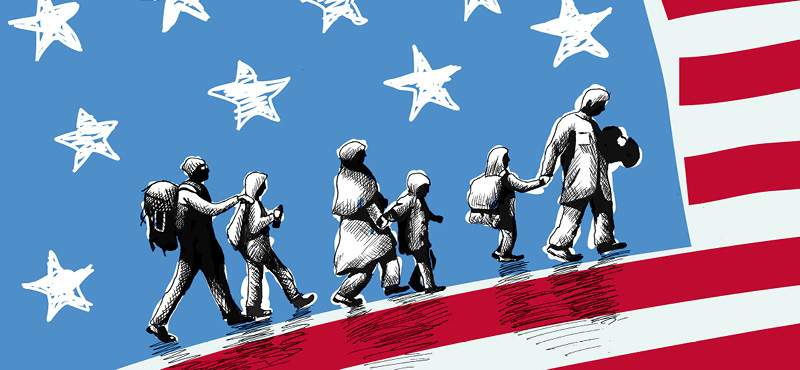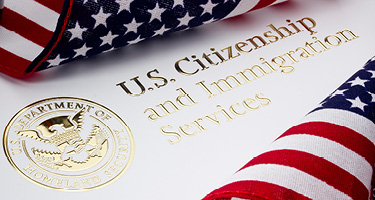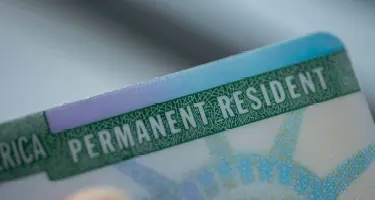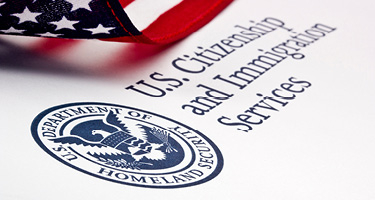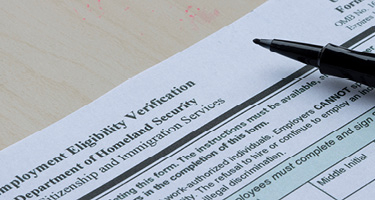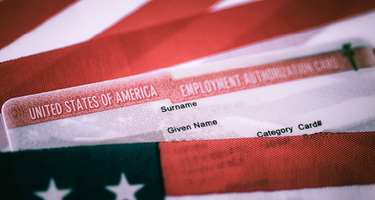A complex framework that governs how foreign nationals enter, live and become citizens of the United States, the U.S. immigration system offers several legal routes for individuals coming to the country, whether to reunite with family, pursue employment, or seek refuge from dangerous situations.
With laws and policies as dynamic as they are complicated, not only is it crucial to understand how the U.S. immigration system works—it’s essential to stay informed.
Recent developments, such as legal challenges to the Biden administration’s Keeping Families Together Act, reflect ongoing shifts in U.S. immigration policy. Designed to protect families during deportation proceedings, KFTA is just one piece of immigration legislation facing obstacles in 2024, highlighting the evolving nature of immigration reform efforts.
This U.S. Immigration Guide provides an in-depth look at the key processes and legislation shaping the immigration system.
United States Immigration System Explained
The U.S. immigration system offers two primary types of visas: temporary and permanent.
Temporary visas allow foreign nationals to live in the U.S. for a specified period, often tied to employment, education, or cultural exchange programs.
Permanent visas, also known as green cards, grant Lawful Permanent Resident (LPR) status, allowing individuals to live and work in the U.S. indefinitely and potentially apply for citizenship.
For those seeking long-term residency, green cards are often the ultimate goal, providing stability and potential U.S. citizenship. Temporary visas, while not directly leading to permanent residency, still play a significant role for workers, students and exchange visitors.
The U.S. immigration system can be broken down into the following categories:
- Family-based immigration: For individuals seeking to reunite with family members.
- Employment-based immigration: For those entering the U.S. for work, either temporarily or permanently.
- Humanitarian protection: For those fleeing persecution or unsafe conditions.
- Diversity visa lottery: A program designed to diversify the U.S. immigrant population by granting permanent visas to individuals from countries with historically low immigration rates to the U.S.
Below, we will discuss each of these categories in greater detail.
1. Family-Based Immigration
Family reunification is a core aspect of the U.S. immigration system. Through family-based immigration, U.S. citizens and green card holders can sponsor close family members to join them in the U.S. This type of immigration falls into two primary categories:
Immediate Relatives
This category includes the spouses, parents and unmarried children under 21 of U.S. citizens. Immediate relatives are not subject to annual visa limits, making their application process faster.
Family Preference Categories
This category includes brothers and sisters, married offspring and adult children of U.S. citizens, along with the spouses and unmarried offspring of lawful permanent residents. The number of available visas in these categories is limited annually.
Children born abroad to U.S. citizens may automatically acquire citizenship at birth, bypassing the typical immigration process, provided their U.S. citizen parent meets certain residency requirements.
Family-based immigration remains one of the most common avenues to permanent residency in the U.S. Families looking to reunite across borders must navigate a detailed application process and deal with fluctuating processing times.
2. Employment-Based Immigration
Employment-based immigration provides skilled workers with opportunities to come to the U.S. through temporary and permanent visa programs. These programs address labor shortages in industries like technology, health care and agriculture. Employment-based immigration is categorized into two main types:
Temporary Work Visas
These visas provide short-term work opportunities in the U.S. and often require employer sponsorship. Some common types include:
- H-1B visa: For specialty occupations requiring advanced knowledge.
- L-1 visa: For intracompany transfers.
- E visas: For treaty investors and traders.
- J-1 visa: For exchange visitors participating in programs like internships or teaching.
- O-1 visa: For individuals with extraordinary ability or achievements in fields like science, arts and business.
- TN visa: For professionals from Canada and Mexico under the U.S.-Mexico-Canada Agreement (USMCA).
- H-2A and H-2B visas: For temporary or seasonal agricultural (H-2A) and non-agricultural (H-2B) workers.
These temporary work visas require employer sponsorship and often involve complex application processes. Legal assistance can ensure compliance with U.S. regulations and streamline the visa process.
Furthermore, these visas are vital in filling essential roles in the U.S. workforce, ensuring that businesses function efficiently while supporting the economy.
Permanent Employment-Based Immigration
Workers can also seek permanent residency through employment. Employment-based green cards are available in five preference categories, which prioritize applicants based on their qualifications and the needs of the U.S. labor market:
- EB-1: Top-tier professionals, including individuals with exceptional talent, distinguished professors and researchers, and senior executives of multinational companies.
- EB-2: Professionals with advanced degrees or exceptional ability in specific fields.
- EB-3: Skilled workers, professionals and other workers with less than two years of experience.
- EB-4: Special immigrants, including religious ministers and workers, as well as personnel employed by U.S. foreign missions.
- EB-5: Immigrant investors who contribute a significant amount of capital to a U.S. enterprise that generates employment opportunities for U.S. workers.
These preference categories play a crucial role in the U.S. economy, particularly in industries that depend on foreign talent. However, challenges such as lengthy processing times and strict visa caps can make it difficult for employers and workers to navigate the system. Increasing the number of employment-based visas and improving the efficiency of the application process are key points of discussion in U.S. immigration reform efforts.
3. Humanitarian Protection
Humanitarian immigration pathways are designed to protect individuals fleeing persecution, war, or other dangerous conditions in their home countries. The U.S. provides humanitarian protection through several programs, including:
- Asylum: Foreign nationals who fear persecution based on race, religion, nationality, political opinion, or membership in a particular social group can apply for asylum. Asylum-seekers must prove they face a credible threat of harm in their home country. Asylum can be sought by individuals already in the U.S. or at a port of entry.
- Refugee resettlement: Refugee status is granted to individuals outside the U.S. who have been forced to flee their home country due to persecution. Refugees must undergo a rigorous application and vetting process before being admitted to the U.S.
- Temporary Protected Status (TPS): TPS is available to individuals from countries experiencing ongoing armed conflict, environmental disasters, or other extraordinary circumstances that prevent safe return. TPS provides temporary legal status and work authorization but does not lead to permanent residency.
Humanitarian immigration programs are often subject to changes in U.S. immigration policy. Shifts in the political landscape can influence how asylum-seekers are processed, how many refugees are admitted each year and whether TPS designations are extended or revoked.
4. The Diversity Visa Lottery
The Diversity Visa Lottery aims to enhance the cultural and national variety within the U.S. by granting green cards to individuals from countries with historically low immigration rates to the U.S. The program issues up to 55,000 diversity visas each year, chosen randomly from a pool of applicants who meet certain educational and employment qualifications.
While the Diversity Visa Lottery provides a direct path to permanent residency, competition is high due to the limited number of visas and the broad eligibility pool. The program’s simplicity makes it an appealing option for those eligible, though the application process must be handled carefully to avoid disqualification.
The Path to US Citizenship
For many immigrants, the path to U.S. citizenship culminates in naturalization, which grants full legal rights and privileges, including the ability to vote.
To apply for naturalization, immigrants must meet several key requirements:
- Maintain LPR status for three to five years, depending on whether their green card was obtained through marriage or other means.
- Fulfill physical presence and residency requirements.
- Demonstrate good moral character.
- Successfully pass tests on English language proficiency and U.S. civics, demonstrating knowledge of the country’s history and government.
Key US Agencies Involved in the Immigration Process
Understanding how U.S. immigration works requires working with several federal agencies, each overseeing a distinct part of the immigration process. Knowing the role of each agency can help streamline your experience and ensure you're following the correct procedures.
- U.S. Citizenship and Immigration Services (USCIS): USCIS is the primary agency handling applications for citizenship, green cards, work permits and visas. It provides resources, forms and updates on case statuses. Immigrants often deal with USCIS for family-based and employment-based immigration, asylum and naturalization.
- U.S. Customs and Border Protection (CBP): CBP is responsible for securing the nation's borders and regulating entry into the United States. CBP officers review documentation and determine admissibility at U.S. ports of entry.
- U.S. Immigration and Customs Enforcement (ICE): ICE enforces immigration laws within the U.S., including investigating illegal immigration and overseeing detention and removal proceedings.
- Department of State (DOS): The DOS is responsible for issuing visas through U.S. embassies and consulates globally and administering the Diversity Visa Lottery program.
- Department of Labor (DOL): The DOL plays a key role in certifying that hiring foreign workers won’t negatively impact U.S. workers, especially for employment-based visas.
Executive Office for Immigration Review (EOIR): Under the Department of Justice, the EOIR administers immigration courts where deportation, asylum and other immigration cases are heard.
By staying informed and seeking the right guidance, applicants can navigate the immigration system more smoothly and avoid common pitfalls.
USA Immigration Law Overview
The U.S. immigration system is governed by a series of federal laws, regulations and executive actions that have evolved over time. Some of the key laws shaping U.S. immigration policy include:
- The Immigration and Nationality Act (INA): This is the foundational law that outlines the different categories of immigration visas, eligibility requirements and the rights and responsibilities of immigrants.
- The Refugee Act of 1980: This law established the U.S. refugee resettlement program and set the legal framework for asylum.
- Executive actions: Various presidents have issued executive orders that directly impact immigration, such as the creation of the Deferred Action for Childhood Arrivals (DACA) program, travel bans, or changes to enforcement priorities.
Changes to immigration laws and policies can occur through legislative reforms or executive orders, often leading to significant shifts in visa availability and eligibility.
USA Immigration Legislation: Key Updates
The U.S. immigration system is currently under significant pressure due to decades of legislative stagnation and changing executive orders. Reform efforts, such as the U.S. Citizenship Act of 2021, aim to address key challenges by increasing visa caps, streamlining processes and reducing backlogs. However, the success of these reforms depends on gaining political consensus in Congress, which has historically been difficult to achieve.
A key piece of pending immigration legislation is the Keeping Families Together Act, which seeks to prevent family separations during deportation proceedings. The legislation remains in legal limbo, as it faced a significant challenge in August 2024 when a U.S. District Court placed an administrative stay on the Department of Homeland Security's ability to grant parole under the act. The act’s fate reflects the broader difficulties the U.S. faces in modernizing its immigration policies.
Possible Future Scenarios in US Immigration Policy
As we look ahead, several possible changes could shape U.S. immigration policy and address important challenges in the system.
Family Reunification Reforms
Family-based immigration currently faces significant delays, with applicants from countries like Mexico and the Philippines waiting years due to per-country limits. As of 2023, nearly four million people were in line for family-sponsored visas. To address these delays, legislative proposals suggest increasing visa caps and improving processing efficiency within USCIS.
Future reforms could also prioritize certain family categories, aiming to reduce wait times for close relatives while balancing family unity with the system’s capacity. These changes may help ease backlogs and provide a clearer pathway for families seeking reunification.
Employment-Based Visa Reforms
As industries like technology and health care continue to face significant labor shortages, legislative proposals are focusing on increasing the annual cap for H-1B visas, which currently stands at 85,000 for 2024. The demand for foreign skilled workers remains high, with 780,884 H-1B registrations submitted, far exceeding the available visas.
In addition to raising the visa cap, simplifying the application process for skilled workers, such as streamlining the PERM labor certification, is also a key area of reform. These efforts aim to reduce barriers for employers and attract foreign talent to address critical gaps in the U.S. workforce.
Asylum and Border Policy Adjustments
The asylum process is another area ripe for reform. With record-breaking numbers of asylum-seekers and an overwhelmed immigration court system, legislators may focus on streamlining asylum applications and reducing case backlogs.
Efforts to modernize border security could also lead to stricter enforcement measures balanced with humanitarian policies for those fleeing dangerous conditions.
These potential scenarios highlight the dynamic and evolving nature of U.S. immigration policy, with legislative reforms and political shifts shaping how the U.S. immigration system will work in the future.
Guiding You Through the US Immigration Process
Navigating the U.S. immigration system can be daunting, but with the right knowledge and support, it’s possible to achieve your immigration goals. Whether you're pursuing family reunification, employment opportunities, or humanitarian protection, understanding how U.S. immigration works is key to making informed decisions.
If you're seeking legal guidance, connecting with an experienced immigration lawyer can make all the difference. Explore immigration lawyers on Best Lawyers® to get the assistance you need to successfully navigate the U.S. immigration process.

